Circumnavigating the frozen zone
Five fortnights walking the perimeter
And after that ...
20 November 2001 to 4 July 2002
Copyright © 2002-2005 Diane Fisher.
photos: adpFisher
This project was truncated several
weeks shy of when I'd have wanted to conclude
it by a situation whose details I won't inflict
on you (landlord-tenant stuff--ended as abruptly
and unexpectedly as it started). That's over,
but it disrupted the process irreparably.
Although I continued to spend about the same
amount of time downtown, I was too distracted
to keep notes routinely and in any event wouldn't
have had time to impose order on them. One day
I may try to collect my mental notes, but I
suspect they're fading without my even being
aware. What comes readily to mind--below--will
probably have to do. --adpF, 4 July 2002
With balletic finesse and noisy blunt force,
wrecking crews brought down 5WTC and slowly,
slowly but eventually, the last of 6WTC in
November and December 2001. Much of the north
tower had fallen into 6WTC and much of 5WTC's
frame had continued to stand upright after
the towers' collapse and the fires.
Beam by beam, girder by girder, column by column,
the inexplicably exquisite skeletal remains of
the towers were depleted to nothing, satisfying
survivor-family demands and disappointing New
York City residents who'd envisioned a small
section staying in place as part of a memorial.
The metal was cut to fit on long flatbeds that
wound around the city's oldest streets, tortuous
and narrow, or up Vesey, to West Street and
the cranes at Pier 25 that lifted the metal
and swung it over onto barges. Big dump trucks
delivered tons of rubble. The circular parade
never stopped. Trucks were always wet, hosed
down exiting the site, hosed down again on
arrival at the nearby pier. Streets were always
wet and gray with the washed-off dust.
No more identifiable structural fragments were
visible from the perimeter of the frozen zone
by the end of December. What remained to be
done was underground.
![[photo]](gx/_wtc02po.jpg)
And by the end of the year the fires and that
vile stink finally were extinguished. While I'd
recognize the stink again in an instant, I can't
swear that I'll always remember it because, oddly,
in truth I've forgotten how it smelled.
Air-testing meters still are all over the place,
but around here E.P.A. credibility is near-zero.
No surprise. Christie Whitman was no stranger to us.
Door of the federal building on
Church at Vesey, mid-June 2002.
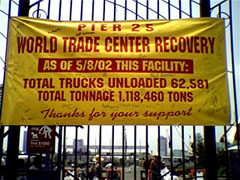
The parade kept rolling. The frozen zone
shrank sidewalk by sidewalk in winter and
spring to little more than the site itself.
Some cops grew testy. I was threatened
with arrest. ...
A fellow who works in the office building
opposite St. Paul's told me about running up
Broadway after the attack. When he and his
co-workers got to Canal Street, he looked over
his shoulder and the north tower fell. He said
his reaction had been, Oh, the other tower's
gone too?--in the detached tone you might use
to observe, Oh, you're out of Roquefort? They
kept running. ...
After I saw the Winter Garden listed as a
structure rescue crews were forbidden to enter
under any circumstances last fall, I jumped to
the conclusion it had been damaged beyond repair.
The WFC plaza was reopened pretty quickly, and
I'd sit at water's edge on raw, gloomy days
gazing sadly at the scaffolding jungle inside
the atrium. Before long, during one of those
sittings I spotted a hardhat nearby. Incredulous,
I asked if it was going to be repaired. He said
he thought so. That may have been my happiest
civic moment since the attack. A few days later
another
![[photo]](gx/_wtc09wg.jpg) hardhat gave me a tentative probably.
I finally relaxed when the Times ran a piece
about the reconstruction <link on Winter
Garden photo page>.
The last hardhat I talked with said the goal
is to finish in time for 11 September
ceremonies. I doubt the likes of you and me
will get anywhere near. Wonder if I could pass
as a "Web journalist."
hardhat gave me a tentative probably.
I finally relaxed when the Times ran a piece
about the reconstruction <link on Winter
Garden photo page>.
The last hardhat I talked with said the goal
is to finish in time for 11 September
ceremonies. I doubt the likes of you and me
will get anywhere near. Wonder if I could pass
as a "Web journalist."
Beyond the pit,
Winter Garden from Church at Dey, 9 July 2002--
with a lot more light passing through
than has been seen in a long time,
suggesting that some of the interior
scaffolding has been removed
Increasing waves of tourists from all points
peered respectfully at what was no longer
there, some from the viewing platform next to
St. Paul's graveyard. The platform had hardly
got going when the section of Church Street under
it reopened to foot traffic. (One construction
worker told me that all that could
be seen from the platform was the roofs
of the construction trailers that blocked
the view from Church Street.
He didn't say whether he knew that from
first-hand experience.) <9 July: The platform
may have passed into lore. Nobody was on it two days
ago--a Sunday--or today.>
![[photo]](gx/_wtc3pit.jpg)
A few of the construction
trailers and shacks, from Church at Vesey, mid-June 2002.
The once spontaneous and poignant
tribute-hung fences around St. Paul's
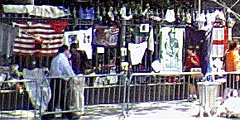 looked increasingly, to put it as politely as possible,
like a calculated flaunting of unwashed laundry.
More than a month after the pit had become
a construction site, the display still was
hanging. St. Paul's was such a vital and
valued relief station for rescue and recovery
crews, I guess they must know what they're doing.
looked increasingly, to put it as politely as possible,
like a calculated flaunting of unwashed laundry.
More than a month after the pit had become
a construction site, the display still was
hanging. St. Paul's was such a vital and
valued relief station for rescue and recovery
crews, I guess they must know what they're doing.
While the vulture vendors of WTC ghoulabilia
offend me no less than when they first turned up,
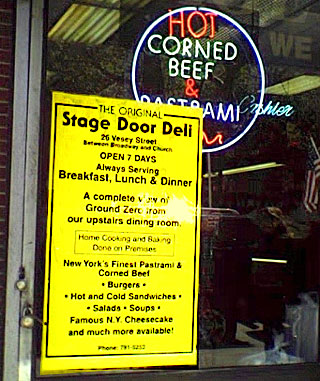 I have no argument with neighborhood businesses
that do things like the Stage Door Deli, where
rescue crews camped out for weeks and which,
since reopening, requires a very modest purchase
<photo update>
for use of its upstairs dining room overlooking the
site. Nobody who wasn't there knows what those
merchants experienced personally that morning
or financially in the months after. But anybody
who walked around downtown during the recovery
knows the amusingly aggressive Dakota
I have no argument with neighborhood businesses
that do things like the Stage Door Deli, where
rescue crews camped out for weeks and which,
since reopening, requires a very modest purchase
<photo update>
for use of its upstairs dining room overlooking the
site. Nobody who wasn't there knows what those
merchants experienced personally that morning
or financially in the months after. But anybody
who walked around downtown during the recovery
knows the amusingly aggressive Dakota
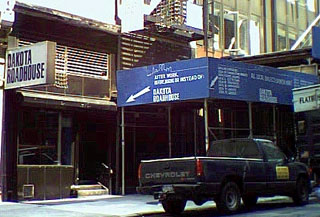 Roadhouse efforts at, uh, "outreach."
Scaffolding in front of the joint lists the
local dialects spoken--union locals
(photo 12 June 2002).
The jeans store that was so damaged reopened
with a museum-grade sealed-glass exhibit at
the front inside of gray dust-coated merchandise
just as it was when it became the subject
of so many photos taken immediately after
foot traffic was allowed again on that part
of Broadway and the door and display windowglass
still were missing (the Times ran a small
feature on the exhibit). The closer stores
are to the site, the more likely you are
to see homemade displays--
Roadhouse efforts at, uh, "outreach."
Scaffolding in front of the joint lists the
local dialects spoken--union locals
(photo 12 June 2002).
The jeans store that was so damaged reopened
with a museum-grade sealed-glass exhibit at
the front inside of gray dust-coated merchandise
just as it was when it became the subject
of so many photos taken immediately after
foot traffic was allowed again on that part
of Broadway and the door and display windowglass
still were missing (the Times ran a small
feature on the exhibit). The closer stores
are to the site, the more likely you are
to see homemade displays--
![[photo]](gx/_wtc1hall.jpg)
Display window of a franchise store on Church Street
a block and a half north of ground zero, 9 July 2002
snapshots and such--along with the usual
merchandise in the windows. Stores near
the site that still are open, that is.
Nino's, the Canal Street restaurant that
closed its doors to the public to serve
as a food and relief station for cops and
rescue workers, chose not to reopen (not
because of proximity) when those services
no longer were needed. I wonder where that
quilt went that was made by poor Texas grade
school children and presented by a district
school official and his wife the day I ate there. ...
The "Tribute in Light" twin laser
beams sounded to almost everyone like a swell
idea and the concept had practical appeal:
It could be done quickly and, as such things
go, cheaply. In execution--well, if it fell
far short of stunning, no blame attached and
it was a harmless distraction. The best that
can be said is that some of the online folk
art the beams inspired rivals the best
of Elvis oil on velvet kitsch. ...
The weather gods continued to smile all winter
on recovery crews digging ever deeper into the
pit, well ahead of schedule, and on this battered city.
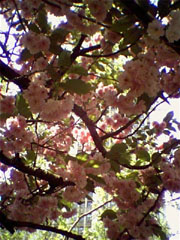 Spring brought a giddy profusion of cherry
blossoms (I guess they are, I'll add with
embarrassment) overhead all over, and flowers,
more daffodils and tulips than could have been
imagined, too many, too much, which was exactly
the right amount, flowers everywhere you looked
<photo update>,
thanks to the generosity of the Dutch nursery
B&K Bulbs, the city of Rotterdam, and the
New Yorkers who planted the bulbs last fall.
I think the Dutch posies achieved their goal:
Spring was a subtle but real psychological
turning point among folks who hadn't been directly
affected, definitely for the better if the mobs
who've been shopping at Century 21 since
it finally reopened are any measure
<update>.
Spring brought a giddy profusion of cherry
blossoms (I guess they are, I'll add with
embarrassment) overhead all over, and flowers,
more daffodils and tulips than could have been
imagined, too many, too much, which was exactly
the right amount, flowers everywhere you looked
<photo update>,
thanks to the generosity of the Dutch nursery
B&K Bulbs, the city of Rotterdam, and the
New Yorkers who planted the bulbs last fall.
I think the Dutch posies achieved their goal:
Spring was a subtle but real psychological
turning point among folks who hadn't been directly
affected, definitely for the better if the mobs
who've been shopping at Century 21 since
it finally reopened are any measure
<update>.
After the 30 May ceremony marking
the end of recovery work, the west side
of Church Street next to the pit and--on the WFC
side--Vesey down to West Street finally were opened
to pedestrians. Every vehicle exiting the site continues
to be hosed down.
![[photo]](gx/_wtc1pit.jpg)
Eastward, from Vesey at West Street, 20 June 2002
Italian visitors had asked last fall which WTC
building was which; in June a young German asked
where the WTC buildings had been. She'd said she
had a dumb question, I'd said a cop had told me
there are no dumb questions. How high were they,
she asked. When you stand next to the site, that
question is harder to answer than you might
think. That close up, it's difficult now to
visualize how extraordinarily high they were.
Higher than any building you've probably ever
seen, I said, more than two and a half times as
high as ... turning ... we stood on the Trade
Center side of Church nearly in the shadow of
the Pirate Jenny of WTC neighbors. She was
surprised when I told her that that sinister
black skyscraper--the one you see in so many
photos--is the Deutsche Bank Building. At
that moment, crews for the first time were
searching the badly damaged and contaminated
building (the Times called it a crypt) for
more body parts. When that--as it turned out,
fruitless--search ended 24 June, the job at
ground zero really was done--months early,
under budget, with no fatal injuries.
<clarification, 16 July: The
recovery effort at Fresh Kills officially
concluded yesterday; the id process at the
morgue is expected to continue for months.>
Bechtel, the G.O.P. international construction
monolith the feds tried to force on us to conduct
the recovery phase, might want to consult the
New York City strategists and folks who did the
work 24/7 from minutes after the attack on how
to do a project of staggering proportion right.
They deserve to be as proud as they are of the
mythic job they did. ...
![[photo]](gx/_wtc44fs.jpg) Should I mention that as I finish writing
this, on the 4th of July, air space over
Manhattan has been closed to all civilian
traffic and F16s are patrolling as they were
on 11 September and the days after? Well, I
know now where the closest fallout shelter
is--wouldst that it could protect our
fading democracy from an administration that
I believe will stop at nothing to keep power.
Should I mention that as I finish writing
this, on the 4th of July, air space over
Manhattan has been closed to all civilian
traffic and F16s are patrolling as they were
on 11 September and the days after? Well, I
know now where the closest fallout shelter
is--wouldst that it could protect our
fading democracy from an administration that
I believe will stop at nothing to keep power.
Leroy Street, 22 July 2002
I've tried to stay divorced from preliminary
discussions of the site's future ... but ==>
What next?
--adpF, 9 June-9 July 2002
|
|
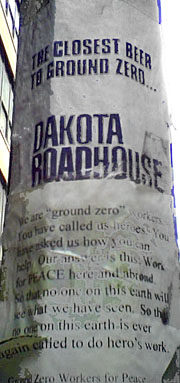
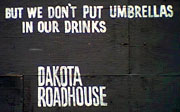
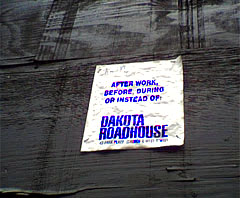
![[photo]](gx/_wtc01ps.jpg) When you notice how close this Battery Park
City schoolyard is to ground zero you can
understand parents' concern about the attack's
psychological and physical after-effects.
When you notice how close this Battery Park
City schoolyard is to ground zero you can
understand parents' concern about the attack's
psychological and physical after-effects.



![[photo]](gx/_wtc01ps.jpg) When you notice how close this Battery Park
City schoolyard is to ground zero you can
understand parents' concern about the attack's
psychological and physical after-effects.
When you notice how close this Battery Park
City schoolyard is to ground zero you can
understand parents' concern about the attack's
psychological and physical after-effects.
![[photo]](gx/_wtc0610.jpg)